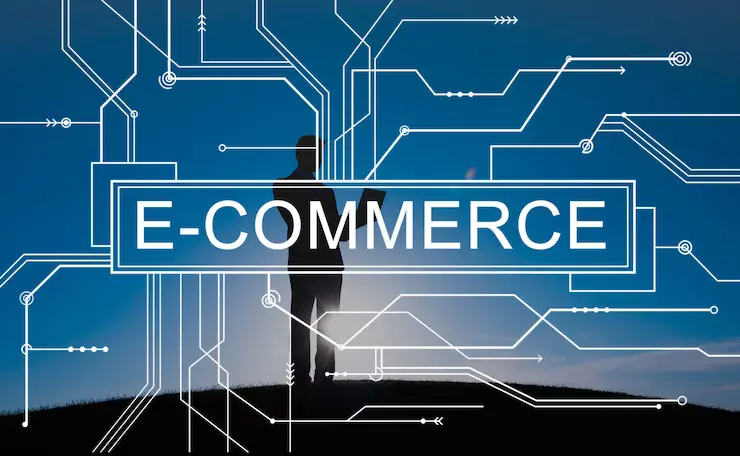Ecommerce security threats are a huge problem for online trading. From vendors to customers, anybody can fall victim to an ecommerce security issue if proper measures aren’t taken beforehand. Ecommerce has also become the latest target for cybercrime all over the world. For example, ecommerce cybersecurity reports have revealed that 54% of ecommerce businesses have at least suffered a successful online security attack once.
In short, ecommerce security is a huge issue, and businesses must be careful of potential threats. In this blog, we will explore the various types of ecommerce security threats and how to eliminate them. So stick with us as we define these threats and provide their solutions!
What Are Ecommerce Security Threats?
Ecommerce security threats simply refer to viruses or security breaches that can risk any of the activity of an online store. For example, breaches in customer data, fraud, scams, or malicious attacks on software. To mitigate these security threats, online businesses have to take several measures. It is imperative for an online store to protect its customers’ data and maintain a secure online environment, fostering trust and confidence in its brand.
Importance of Prioritizing Ecommerce Security
Prioritizing ecommerce security is crucial for several reasons. Firstly, it helps protect customer data, including sensitive information such as credit card details and personal data, safeguarding them from potential data breaches and identity theft. By prioritizing security measures, businesses demonstrate their commitment to customer privacy, earning trust and loyalty.
Secondly, ecommerce security helps mitigate financial loss. A successful security breach can result in significant financial repercussions, including legal costs, compensation to affected customers, and damage to the company’s reputation. Prioritizing security minimizes the risk of such incidents and ensures the financial stability and sustainability of the business.
Lastly, prioritizing ecommerce security fosters a positive user experience. When customers feel secure and confident in their transactions, they are more likely to engage with the website, make purchases, and recommend the business to others, leading to increased revenue and growth.
15 Worst Types of Ecommerce Security Threats
Now that we know the meaning of ecommerce security threats and why prioritizing security is important, let’s discover different types of ecommerce threats. This list will discuss the 15 worst types of ecommerce security threats businesses can face. Read the details of each carefully to find the right solutions:
- Spam
- Phishing
- Financial Fraud
- Bots
- DDoS Attacks
- SQL Injections
- Trojan Horses
- XSS
- Brute Force Attacks
- Malware
- Exploitation of Vulnerabilities
- Man in the Middle (MITM)
- e-Skimming
- Website Hacking
- PCI Non-compliance

1. Spam
The number one and most common security threat for ecommerce businesses is the infamous “Spam.” Email marketing is a great way to connect with customers, but emails are often used for spamming. However, comments on your blog or contact forms are an open invitation to online spammers, who will leave infected links to hurt you. They can be sent through your social media inbox for you to click on them and get exposed to a virus. Furthermore, spamming degrades not just the security of your website but also its speed.
2. Phishing
Online store owners often complain of customers receiving fraudulent emails from hackers pretending to be legitimate business people. They show them fake copies of a business or website’s products, promotional offers, etc., in hopes of scamming them for money. Sometimes customers fall into their trap or give them their personal information. This can hurt both the customer and damage a business’s reputation.
3. Financial Fraud
Financial frauds are like the most common ecommerce security threat ever since online businesses started worldwide. Usually, customers fall victim to credit cards or fake return/refund fraud. Credit card frauds happen when a cybercriminal steals someone else’s credit card information and uses it to purchase products online. Thanks to modern Address Verification Systems (AVS), you can find the location where such activity emerges from and track the fraudster.
While ecommerce businesses are infamous for scamming customers in fake return or refund cases, fraudsters also have a way of doing that. Hackers sometimes file fake requests for returns and refunds and cause businesses great losses.
4. Bots
Brace yourself for the mischievous bots! These digital troublemakers are like sneaky spies infiltrating your eCommerce kingdom. They can scrape sensitive data, overwhelm your servers, or even manipulate prices. Many store owners don’t know about this, but bots are also used by attackers to collect private data of an ecommerce site. Don’t let them wreak havoc on your online business—be vigilant and deploy powerful security measures to keep these bots at bay!
5. DDoS Attacks
Short for Distributed Denial of Service, DDoS attacks aim to overwhelm your website or network with an avalanche of traffic, rendering it inaccessible to genuine users. Hackers utilize compromised computer networks to flood your server with requests, causing it to slow down or crash altogether. Implementing DDoS mitigation strategies, such as traffic filtering and load balancing, can help safeguard your ecommerce platform against such attacks.

6. SQL Injections
Hackers can inject malicious SQL queries into your database by exploiting vulnerabilities in your website’s code. By doing this, they can potentially gain unauthorized access to sensitive customer information. Proper input validation and parameterized queries can help prevent these attacks, ensuring the security of your ecommerce database.
7. Trojan Horses
Just like the mythical wooden horse that led to the fall of Troy, Trojan horses are disguised as harmless software or files, but once inside your system, they unleash chaos. These malware-infected programs can steal customer data, install additional malware, or even grant remote access to hackers. Employing robust antivirus software, conducting regular system scans, and educating your employees about the dangers of downloading unknown files can help protect your ecommerce platform from Trojan horses.
8. XSS
Cross-Site Scripting (XSS) attacks occur when hackers inject malicious scripts into web pages viewed by unsuspecting users. This can enable attackers to steal sensitive information, manipulate website content, or perform unauthorized actions on behalf of users. Protecting against XSS attacks involves implementing proper input sanitization and output encoding and staying updated on security best practices.
9. Brute Force Attacks
Hackers can employ brute force attacks to gain access to user accounts or administrator panels by systematically trying various combinations of usernames and passwords until they find the correct ones. Implementing strong password policies, enabling multi-factor authentication, and using account lockouts after multiple failed login attempts can significantly reduce the risk of successful brute-force attacks.
10. Malware
Malware, short for malicious software, refers to various dangers such as viruses, worms, ransomware, and spyware. These dangerous programs might compromise client data or interrupt routine operations by infiltrating your ecommerce system. Updating your antivirus software regularly, avoiding dubious downloads, and training personnel about safe online practices are all critical steps in combating malware attacks.

11. Exploitation of Vulnerabilities
Software bugs are like unlocked doors for hackers. Attackers can gain unauthorized access, execute arbitrary code, or circumvent security restrictions by exploiting these flaws. Staying on top of software updates, deploying patches as soon as they become available, and conducting regular security audits can help discover and mitigate any vulnerabilities, lowering the chance of exploitation.
12. Man in the Middle (MITM)
A Man in the Middle attack occurs when a hacker intercepts communication between two parties and secretly monitors or changes the data sent. This poses a significant risk to ecommerce systems since sensitive client information, such as credit card numbers, may be hacked. Encryption technology and secure communication protocols, such as HTTPS, can assist in protecting against MITM attacks.
13. e-Skimming
The theft of payment card information from online purchases is known as e-skimming, web skimming, or Magecart attacks. Cybercriminals inject malicious malware into your ecommerce website, capturing payment information as users make transactions. This stolen information can subsequently be utilized to commit fraud. To prevent e-skimming, adopt strong security measures such as secure payment gateways, routinely monitor website code for unusual changes, and undertake vulnerability audits.
14. Website Hacking
Unauthorized access to your ecommerce platform through vulnerabilities in security is referred to as website hacking. Hackers may deface your website, steal important client data, or take complete control of your system. Implementing strong passwords, using secure hosting services, frequently updating your website’s software, and monitoring for any suspicious activity or unauthorized access attempts are all part of securing your website.

15. PCI Non-compliance
PCI noncompliance is a major security risk for e-commerce enterprises. Multiple vulnerabilities emerge when a merchant or service provider fails to meet the Payment Card Industry Data Security Standard (PCI DSS) criteria. To begin with, noncompliance raises the risk of data breaches, which could expose critical cardholder information to thieves. Loss of customer trust and company reputation harm can have long-term consequences, resulting in lower sales and negative reviews.
Furthermore, non-compliant enterprises may face regulatory fines, penalties, and legal action from aggrieved customers. Businesses can protect cardholder data, preserve customer trust, and gain a competitive advantage in the e-commerce market by conforming to PCI DSS rules.
Best Solutions to Keep Your Site Safe From These Threats
Encountering these threats can really be terrifying for an online store owner. But don’t worry! We have the best solutions for you to safeguard from these ecommerce security threats. Here are 7 common safety measures which you can take to be safe from security issues:
- HTTPS and SSL certificates
- Secured Admin Panel and Server
- Using Anti-malware and Anti-virus software
- Secured Payment Gateway
- Use Firewall
- Ecommerce Security Plugins
- Backup Data
HTTPS and SSL certificates
Implementing HTTPS and obtaining SSL (Secure Sockets Layer) certifications for your website is critical. HTTPS encrypts communications between your website and users, ensuring that sensitive data, such as client information, is securely transmitted. SSL certificates give an extra layer of confidence by validating the legitimacy of your website. This aids in the prevention of man-in-the-middle attacks and ensures data integrity.
Secured Admin Panel and Server
Securing your admin panel and server is critical to prevent unauthorized access to important portions of your ecommerce platform. For administrator accounts, use strong passwords and impose multi-factor authentication. Update and patch your server software regularly to resolve any security flaws. Limit access permissions to only those who need them, and monitor and log admin panel activity regularly.
Using Anti-malware and Anti-virus software
Using trusted anti-malware and anti-virus software is critical to detect and remove harmful software from your PCs. These tools aid in the prevention of malware infections, trojan horses, and other dangerous threats. Maintain frequent software updates to protect against the latest attacks and run regular system scans to identify and eradicate potential dangers.
Secured Payment Gateway
Choosing a secure payment gateway is critical for safeguarding your clients’ payment information. Select a reliable payment service provider that adheres to industry security requirements and uses encryption technologies. This ensures that sensitive payment data is sent and processed securely, lowering the danger of e-skimming attacks and unauthorized access to financial information.

Use Firewall
Installing a firewall creates a barrier between your ecommerce website and potential attackers. A firewall monitors and filters network traffic, preventing suspicious or harmful activities. Configure your firewall to allow only needed services and ports, effectively minimizing the attack surface area.
Ecommerce Security Plugins
Use ecommerce security plugins or extensions that are specifically developed to improve your platform’s security. These plugins may include real-time monitoring, vulnerability scanning, and banning questionable actions. Select credible plugins from reliable sources and maintain them up to date to offer the best protection against evolving threats.

Backup Data
The last one on our list for solutions to ecommerce security threats is the traditional duty of backing up data. Regularly tidying up your ecommerce website and its data is critical for speedy recovery in case of a security incident or data loss. Make sure backups are securely maintained on remote servers or offline storage devices. Implement a comprehensive backup strategy that includes backups of databases and files and regularly test the restoration process to confirm its effectiveness.
Final Thoughts
Time to wind up our discussion on the 15 worst types of ecommerce security threats. We’ve learned so far that from harmful software attacks to cybercrimes, all types of security issues can be resolved if careful measures are taken beforehand. Some businesses take this issue for granted and do not take proper assistance. However, a business cannot thrive without promising its customers trust and credibility.
Our advice is to stay alert to these threats and consistently check your website’s safety. If you find it difficult, you can always contact Shopsmith to provide safety solutions. We value your brand’s reputation and have a team of professionals that can ensure the best online practices for your company. Until then, Good Luck with your business endeavors!
FAQs
What is meant by security vulnerabilities in ecommerce?
Ecommerce security vulnerabilities are issues like cross-site scripting, data leaks, data manipulation, etc., that can cause exploitation of a business’s data and resources.
Which main certificate is necessary for ecommerce?
Secure Sockets Layer (SSL) certificates are necessary for ecommerce websites to verify their identity and serve as an encrypted connection. These certificates protect credit card details and other important personal data of a business.




